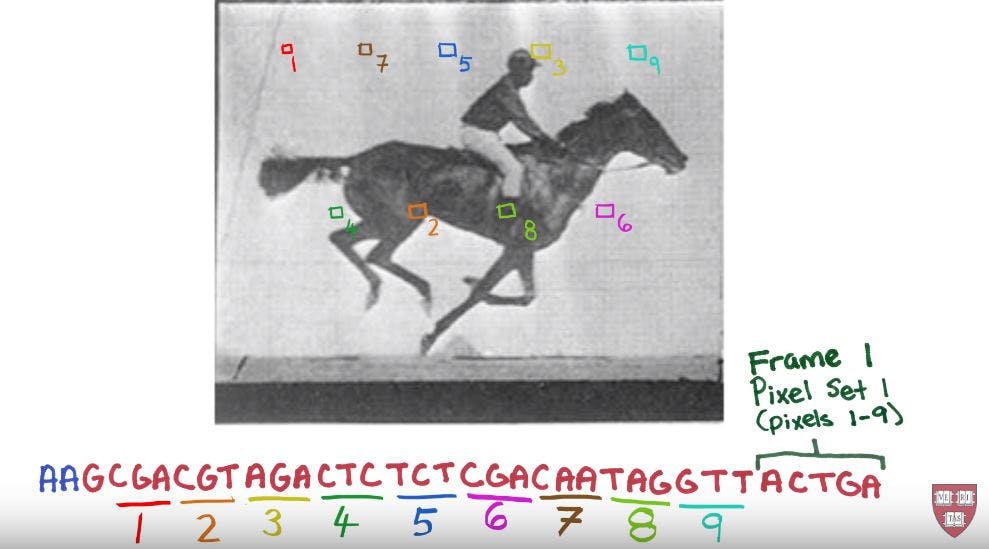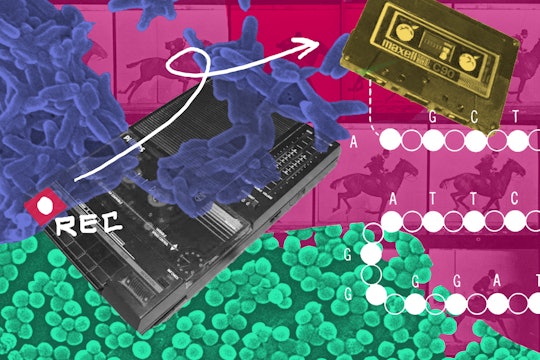The galloping horse video that made news was just the first step.
The scientific process hinges on our ability to measure, record, and tell a story accurately. For centuries, scientists have been refining the tools they use to understand the natural world. Nowadays, satellites record microwave emissions around the world to shine a light on rising global temperatures. It’s hard to fathom that 200 years ago, temperature measurements could only be done with simple thermometers. But ‘how’ only comes after ‘what’: scientists must first understand exactly what they’re trying to measure before they dive into data collection.
In the world of cell biology, structures that once evaded the most insightful instruments can now be easily seen and recorded under a microscope. And the bar was just raised on the scientific process when a group of researchers at Harvard Medical School, led by Dr. George M. Church, encoded a photographic sequence captured by Eadweard Muybridge in 1878 depicting a galloping horse in the DNA of living bacteria.
The study made news for its cool factor, but it also has large potential for research: this could, for the first time, allow scientists to view the cellular events in a continuous stream, showing us how seemingly disconnected moments fit together on a timeline.

To store the animation, Church’s team used CRISPR, a gene editing strategy that co-opts the natural bacterial immune system. Normally, this system protects bacteria from the invaders they encounter most often: viruses. When viruses inject their DNA into bacterial cells, as they normally do when mounting an attack, bacteria respond by rallying molecular scissors that dice up viral DNA into function-less fragments. To secure their long-term safety, the bacteria store some of these fragments in their own genetic code so they can initiate a faster response if they’re attacked again–a memory, of sorts.
Importantly, writing these memories into their DNA is done in a temporal sequence–precisely why Church’s novel approach could work. Seth Shipman, the study’s first author, manipulated the building blocks of DNA into a code that corresponded to the pixels of a single frame. By chance, one bacteria may have received the code for pixels 1 to 10, while another was supplied with pixels 11 to 20. When their DNA was extracted, it would have all the information needed to reconstruct a complete 20-pixel image. By playing with the order in which bacteria were fed the encrypted DNA, the authors made sure that the playback followed a frame-by-frame timeline. In the process, Shipman did much more than turn bacteria into a conduit for animation – he also liberated our ability to record biological data from its traditional restraints.
As Shipman highlights in a video published by Harvard, the challenge with prior techniques is that, “if you’re trying to get information out of cells, you have to either be watching them or disrupt the system–take the data out of the cells.” We disrupt the system momentarily–by treating cells with a certain drug or growing them in specific conditions–and see how it responds, thus attempting to unravel the mechanisms at play in healthy and diseased tissue. But our current window is transient. With Shipman’s approach, we could leave the recorder rolling for a cell’s entire lifetime by directing cells to record their history in the background. Doing this would require that cells stamp their day-to-day processes into a DNA code that we could later retrieve.
“Harnessed further, this approach could present a way to cue different types of living cells in their natural tissue environments into recording the formative changes they are undergoing into a synthetically created memory hotspot in their genomes,” Church told the Harvard Gazette. The team hopes that recording microscopic memories of the events in a cell’s lifetime could cast light on many of the processes that we still don’t understand, beginning with the brain.
To put that into perspective, neuroscientists broadly agree that the leaps and bounds we’ve made in understanding how the brain works pale in comparison to what is still to be discovered. From understanding how different neurons become committed to a certain function to the study of anatomical neurocartography–exploring variations in brain anatomy within and between species–we’ve only glimpsed the inner workings of the brain. Cellular events that orchestrate how whole areas of the brain develop and communicate with the rest of the body still evade the scope of modern research tools, as do the processes that cause the brain to spiral into diseased states, such as Alzheimer’s, Parkinson’s, and even cancer. And because each cell can execute thousands, if not millions, of processes, gleaning more information on the network of proteins that make those processes happen is vital to advancing medical research.
Take Alzheimer’s disease. It begins when clumps of proteins, called plaques, form in the brain and block normal functioning. We know that the accumulation of plaque begins almost a decade before patients display symptoms. Current treatments do a remarkable job of slowing Alzheimer’s course, but without a clear image of the cellular processes that cause plaque deposits, the curative options are limited.
Imagine if instead we could harness the power of a molecular recording device to watch the process start–in theory, we could come up with strategies to identify high-risk individuals and extend their cognitive lifespan, if not stop their disease progression altogether.
Less than a decade has gone by since scientists puzzled over CRISPR’s mechanism and function. We’ve not only overcome that hurdle–we’ve reached a point where CRISPR can be used as a molecular tape recorder. The possibilities are endless.
(For the source of this article, and to watch a video associated with it, please visit: https://massivesci.com/articles/crispr-cas9-muybridge-horse-jomaa/)










